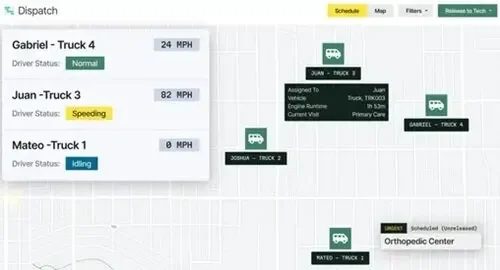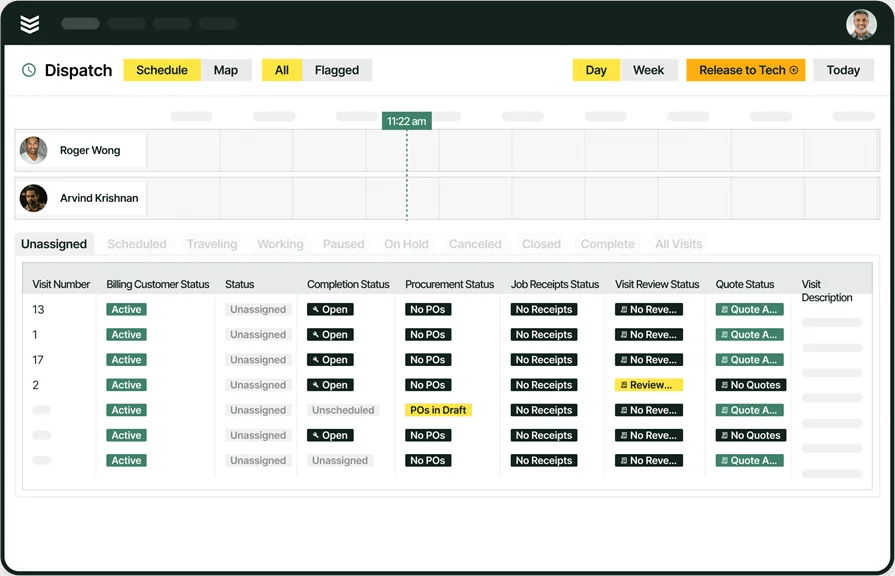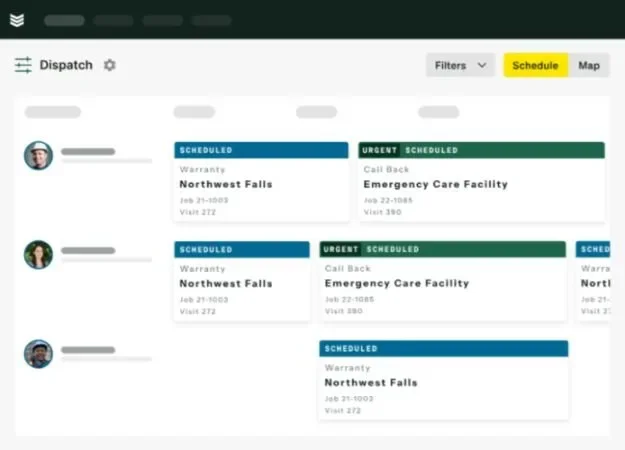When every job hinges on crews being in the right place, with the right tools, at the right time—contractor scheduling keeps everything moving. It separates smooth builds from project delays, missed deadlines, and angry phone calls. Whether you're lining up trades across a large site or coordinating subs on a tight schedule, the contractor schedule of work holds the entire operation together.
Contractors working in field service management environments face added pressure: responding to urgent service calls, managing technicians across multiple job sites, and making sure no crew is double-booked. That makes contractor job scheduling a frontline issue—not just for efficiency, but for keeping projects profitable and clients satisfied. A tight scheduling plan cuts down the chaos. It reduces rework, eliminates downtime, and gives you control over who’s doing what and when. This guide walks through how to build a stronger system from the ground up.
- What is contractor scheduling?
- How to build and improve your contractor scheduling process
- 10 best practices for contractor job scheduling
- Choosing the right contractor scheduling software for your team
- Top tools for contractor job scheduling
Let’s start with what contractor scheduling actually means, and why it’s the foundation for getting work done on time, every time.
What is contractor scheduling?
Contractor scheduling keeps crews, subcontractors, and vendors aligned across every phase of a project. It sets the pace, reduces downtime, and keeps the job on track by assigning tasks in the right order. It’s how you prevent trade conflicts, missed deadlines, and costly scheduling delays.
What goes into the contractor scheduling process?
Managing a contractor schedule takes more than just filling in dates. It’s about aligning labor, tasks, and timelines while staying flexible when things change. A strong system avoids miscommunication, keeps crews efficient, and prevents the job site from stalling. Here’s what to factor in:
- Task sequencing – Each trade depends on the last. If work gets scheduled out of order, you end up with rework and lost time. Line up tasks based on construction flow and inspection windows.
- Labor coordination – Contractors balance in-house crews, subs, and specialists. Keeping the right crew on-site, with space and clear direction, keeps progress steady.
- Site readiness – Crews can’t work if the site’s not prepped. Factor in inspections, material drops, and equipment setup before work starts.
- Conflict avoidance – Too many trades in one spot causes pileups. Spread out work zones and stagger crews to keep everyone moving.
- Schedule adjustments – Delays happen—weather, no-shows, late deliveries. Your contractor schedule of work needs room to flex without breaking the timeline.
A reliable contractor scheduling process ties all these moving parts together. It brings clarity to the crew, structure to the workflow, and confidence to the builder running the job.
What does a successful contractor scheduler do?
A strong contractor scheduler does more than drop names on a calendar—they keep crews moving, subs aligned, and the entire job on pace. They coordinate moving parts, adjust when delays hit, and juggle overlapping schedules without throwing off the build. What separates a solid scheduler from a great one is how they manage pressure: balancing deadlines, labor, and materials without overloading the crew or missing a step.
The best schedulers don’t just fill time slots—they drive the job forward. They monitor progress, track resource availability, and keep communication clear across the team. Think of them as the link between project managers, subcontractors, and the boots on-site. Tools like a field service scheduler show what this role looks like when it’s dialed in—real-time updates, clear job tracking, and flexibility built into every day.
Successful contractor scheduling starts with someone who owns the calendar and understands the jobsite. When that happens, the whole operation runs smoother.
How to build and improve your contractor scheduling process
A strong contractor scheduling process avoids missteps, limits wasted labor, and keeps every trade lined up to hit their mark. Whether you're building from scratch or tuning up an existing system, following a structured plan helps prevent the job from slipping off track.
- Define scheduling priorities – Start by identifying what drives your timeline—speed, inspection deadlines, or crew availability. Set clear rules for what takes priority and how to handle backlogs or shift changes when plans fall apart.
- Match work to crew availability – Not every crew handles every type of work. Match skill sets, equipment, and licensing requirements to the job. That way, the task gets done right without delay or costly callbacks.
- Sequence based on project flow – Trades need to work in order. One delay early on can ripple through the rest of the build. Schedule each task in line with permit signoffs, site readiness, and the actual build sequence.
- Use scheduling software built for the trades – Manual whiteboards or spreadsheets won’t cut it on complex jobs. Digital tools built for scheduling bring clarity, reduce overlap, and help teams pivot fast when plans change.
- Monitor progress and adjust in real time – The first draft of any schedule rarely holds. Jobsite changes, material delays, or labor shortages will force adjustments. Build in a system to track performance, shift resources quickly, and tighten up the schedule as you go.
Contractors managing multiple jobs, sites, and crews need a platform that can keep pace with real-world demands. That’s where tools designed for field service management software come into play—tying together schedules, people, and progress in one system built for the trades.

Try our scheduling tool
Simplify project scheduling so you can book more jobs and increase revenue.
10 best practices for contractor job scheduling
Contractor scheduling can fall apart fast without the right structure. One missed handoff—double-booking a crew, scheduling work out of sequence, or ignoring delays—can ripple across the job. Whether you're managing day-to-day tasks or long-term phases, the goal stays the same: get every crew in, out, and onto the next site without friction.
1. Prioritize urgent tasks without breaking the schedule
Last-minute issues happen—weather delays, failed inspections, surprise repairs. The key is building slack into the contractor schedule of work so urgent items don’t throw everything off. Flex time, buffer zones, and clear escalation steps let you slot in critical work without pushing crews into overtime or knocking trades out of order.
2. Assign work based on skill, not just availability
When scheduling contractors, it’s easy to fill open slots without thinking through matchups. But sending a team to the wrong job slows everything down. The better approach is tying your schedule to qualifications and scope. Platforms that support detailed crew profiles—like those found in contractor dispatch workflows—help ensure every task lands with a team ready to handle it from the jump.
3. Build schedules around jobsite logistics
Even the best crew loses time if they’re bouncing between sites all day. Scheduling around physical location, site readiness, and trade overlap cuts down on dead travel time. For larger crews, tools that include location-aware coordination—like features built into contractor scheduling apps—help cluster tasks efficiently and keep your operation grounded in the field, not on the road.
4. Even out workloads to avoid burnout
One crew is overloaded, another barely working. It’s a familiar problem when managing multiple jobs across multiple subs. Balancing workloads across your contractor schedule helps prevent fatigue and mistakes. Job history, labor hour tracking, and a clear view of active projects all play a role in protecting your team from burnout while still hitting deadlines.
5. Keep clients in the loop to prevent no-shows
When a homeowner or facility manager forgets an appointment, crews lose hours they can’t get back. Miscommunication like this breaks momentum. Contractors using tools with automated updates and two-way messaging—like those found in many contractor CRM systems—can reduce no-shows, confirm service windows, and avoid misfires before they start.
6. Automate repeat work to tighten your schedule
Recurring maintenance and repeat projects shouldn’t require manual entry every time. Automating these tasks keeps the calendar full without extra admin work. A contractor scheduling system that supports recurring job blocks can help teams stay booked and reduce gaps between phases.
7. Keep job history accessible in the field
Crews shouldn’t arrive on-site guessing what happened last time. Being able to pull up notes, past work, and photos keeps jobs moving without delays. Using a mobile-friendly contractor scheduling app gives teams real-time access to job history—no calls, no confusion, just action.
8. Fill gaps fast when plans change
A last-minute cancellation shouldn’t lead to lost billable hours. Contractors who maintain a waitlist or use drag-and-drop rescheduling features can reassign work quickly and keep labor tight. Flexibility on the fly keeps crews working even when the plan shifts.
9. Tie inventory planning to your calendar
If a job’s scheduled but the materials aren’t there, the crew’s stuck. Linking your schedule with inventory helps make sure the right tools and parts show up with the people doing the work. That keeps delays off the board and jobs moving from one stage to the next.
10. Use real-time tracking to stay ahead of issues
Crews get delayed. Traffic builds. Jobs run long. Without visibility, you’re left reacting too late. Tools designed for contractor dispatch management help teams track location, update progress, and shift resources in real time—so you stay ahead instead of catching up.
Choosing the right contractor scheduling software for your team
Manual scheduling might work when you're only juggling one or two crews—but as projects scale, keeping track of job timelines, labor availability, and site readiness gets messy fast. Double bookings, miscommunication, and long gaps between tasks all chip away at project efficiency.
The right contractor scheduling software gives you control over your calendar without living in spreadsheets. Solutions designed for the trades help align field teams, back-office staff, and job progress in real time. If you're exploring options that fit this specific need, this breakdown of contractor scheduling software shows how top tools can help keep jobs moving without delays.
Benefits of using contractor scheduling software for operations
Contractors aren’t just assigning jobs—they’re managing timelines, crews, inspections, materials, and coordination across active sites. When schedules live in spreadsheets or on whiteboards, things fall through the cracks. Purpose-built scheduling software gives contractors the structure and visibility they need to keep jobs moving without constant fire drills. Here’s how it helps:
- Prevents trade conflicts - Smart scheduling keeps overlapping crews out of the same space. You can stagger trades and phase work properly, so subs aren’t climbing over each other or waiting around to start.
- Aligns tasks with project timelines - Whether you're dealing with inspections, concrete cure times, or delivery delays, scheduling tools let you shift timelines quickly without derailing the rest of the build.
- Centralizes labor and resource planning - Instead of calling around to check crew availability, you get a clear picture of who’s booked, who’s open, and where your labor is spread across active projects.
- Improves communication across job roles - From supers to subs to PMs, everyone works off the same schedule. When changes happen, everyone gets notified—no more second-hand updates or missed memos.
- Helps track productivity and job progress - Built-in reporting shows which tasks are behind, which crews are overloaded, and how long phases are actually taking—helping you tighten your next contractor schedule of work.
The right tool doesn’t just fill out a calendar. It gives contractors control over the chaos—so jobs get done in the right order, with the right team, without the usual scramble.

Easily compare software tools
We help you compare software options at a glance so you can find the right fit.
8 contractor scheduling software features that actually matter
Contractor operations aren’t simple. You’re not just assigning tasks—you’re coordinating labor, managing subs, syncing with site timelines, and adjusting when things go sideways. The right scheduling software makes all of that manageable. It keeps projects on pace without burning time fixing preventable mistakes. These features actually make a difference:
- Real-time dispatching and crew coordination - Schedules shift by the hour. Whether a crew runs late or a last-minute task gets approved, real-time updates are a must. A field service dispatch software solution lets you shift job assignments, reroute teams, and update timelines without calling five different people.
- Mobile access for field teams - Crews need to see what’s next, not guess or wait on phone calls. A technician mobile app gives your teams access to job details, updates, site info, and task checklists in real time—right from the field.
- Location tracking and route optimization - Drive time kills productivity. Grouping jobs by site and knowing where your teams are helps avoid wasted movement. Tools like a fleet tracking system make it easier to dispatch crews efficiently and make smarter scheduling calls.
- Integrated service quoting tied to the schedule - If quoting happens in one tool and scheduling in another, things fall through the cracks. A contractor quoting platform that connects directly to your calendar means crews get booked right after approvals—no lag, no extra steps.
- Time tracking for accurate labor scheduling - You can’t plan tomorrow if you don’t know how long today took. Time tracking tools help capture crew hours automatically, giving you a clearer view of how labor is really being used across each phase.
- Recurring work and service agreement scheduling - For contractors handling ongoing service work, long-term maintenance, or warranty follow-ups, a service agreements tool keeps recurring jobs on the schedule without extra admin.
- Pipeline visibility for upcoming jobs - Good scheduling starts before the job’s on the board. Pipeline management tools show what’s coming up—so you can block off crews, prep equipment, and avoid overload before the job even kicks off.
- Reporting tools to improve your scheduling process - Without data, you’re guessing. Reporting tools help uncover patterns—missed windows, overbooked teams, and gaps between trades—so you can fine-tune your contractor schedule of work with every project.
A solid scheduling platform supports more than just your calendar. It keeps your people, tools, and job timelines aligned—so crews hit the site ready, work gets done on time, and the chaos stays off the job board.
Top tools for contractor job scheduling
Choosing contractor scheduling software can transform how jobs get assigned, tracked, and completed. The best platforms give you control over multiple crews, overlapping schedules, and shifting project timelines—without drowning in spreadsheets or last-minute calls. Here’s a breakdown of three top tools, starting with the one built for commercial contractor operations.
1. Best for commercial: BuildOps
BuildOps is built specifically for commercial contractors, offering tools that help manage multi-site jobs, recurring work, and service calls across large teams. It covers everything from real-time scheduling to drag-and-drop dispatch, making it easier to handle high-volume job coordination without falling behind. The platform also connects field teams with office staff using shared schedules, crew availability, and full job context.
Why this is best for commercial: Commercial contractors juggle large teams, complex scopes, and high customer expectations. BuildOps simplifies scheduling with automated job assignment, real-time crew updates, and smart resource allocation.

Try BuildOps Today
See how contractors keep their schedule organized and eliminate chaos.
2. Best for residential: Housecall Pro
Image Source: Housecall Pro
Housecall Pro is a lightweight option for residential contractors. It offers a clean interface for managing appointments, dispatching crews, and sending automated reminders. The platform also includes basic invoicing and payment tools, making it a solid fit for solo contractors or smaller home service businesses that rely on quick turnaround. However, for larger teams or anyone handling high volumes of overlapping work, the features may feel limited and less tailored to complex job coordination.
Why this is best for residential: Residential contractors need tools that simplify fast-moving jobs. Housecall Pro helps manage one-off jobs and maintenance calls easily—though it may not scale well for commercial teams or larger project demands.
3. Best for general contractors: Jobber
Image Source: Jobber
Jobber supports general contractors working across diverse job types, from small installs to multi-day projects. It helps organize schedules, assign jobs, and update task progress with built-in tools for quoting, client management, and job tracking. Its flexible system fits well for small to mid-sized operations with lots of moving parts. Still, contractors working in the commercial space may find that Jobber lacks deeper service management features needed for large-scale scheduling control.
Why this is best for general contractors: General contractors need flexibility, and Jobber adjusts well to shifting timelines and job types. But those managing larger teams or multiple project phases might outgrow its capabilities.
Scheduling is the spine of every contractor’s operation. Whether you're coordinating a single job or juggling crews across multiple sites, a tight schedule keeps everything from slipping. It’s how you avoid idle teams, backlogged work, and angry callbacks. From assigning tasks based on crew skills to adjusting in real-time when delays hit, the right system gives you control—not chaos.
If you’re a commercial contractor dealing with recurring jobs, service agreements, or complex crew logistics, platforms like BuildOps bring scheduling, dispatch, quoting, and job tracking under one roof. No more piecing together apps that don’t talk to each other—just one place to manage the moving parts of your day.

Try our scheduling product
Schedule more jobs and manage your projects easily from a single place.







